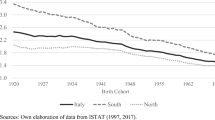Abstract
We consider the contribution of changes in mortality and fertility to availability of living mothers and living children among older people in Britain, Finland and France. The proportion of people aged around 60 with a mother alive will more than double between those born in 1911 and 1970 before starting to decline slightly. Conversely, a higher proportion of elderly people are likely to have a surviving child than for any generation ever born in all three countries in the next quarter century or so, with about 85% of 80-year-old women having at least one surviving child, and about two-thirds having two or more.
Résumé
Cet article analyse la contribution des changements de mortalité et de fécondité sur la probabilité, pour les personnes âgées en Grande Bretagne, en Finlande et en France, d’avoir encore sa mère vivante ou d’avoir des enfants vivants. La proportion de personnes âgées d’environ 60 ans avec leur mère toujours en vie devrait doubler entre les cohortes nées en 1911 et celles nées en 1970, puis baisser légèrement par la suite. De même dans les trois pays, la proportion de personnes âgées ayant un enfant vivant devrait être plus élevée pour les cohortes à naître au cours du prochain quart de siècle qu’elle ne l’a jamais été dans le passé, avec 85 pour cent des femmes de 80 ans ayant au moins un enfant survivant, et deux tiers ayant deux enfants ou plus.
Similar content being viewed by others
References
Arno, P. S., Levine C., & Memmott, M. M. (1999). The economic value of informal caregiving. Health Affairs, 18(2), 182–188.
Beaumel, C., Désesquelles, A., Richet-Mastain, L., & Vatan, M. (2004). La situation démographique en 2002: Mouvement de la population, Institut national des statistiques et des études économiques, Insee resultants—société no 34, 44 p+CD-Rom.
Bechtel, J., Caussat, L., & Loisy, C. (2004). Les comptes de la protection sociale en 2003, Série statistiques document de travail 70. DREES, 121 p.
Bontout, O., Colin, C., & Kerjosse, R. (2002). Personnes âgées dépendantes et aidants potentiels: une projection à l’horizon 2040, Etudes et résultats 160. DREES, février.
Breuil, P. (1998). La dépendance des personnes âgées: recours aux proches et aux aides professionnelles. Portrait social, INSEE: 91–107.
Brutel, C., & Omalek, L., 2003. Projections démographiques pour la France, ses régions et ses départements: Horizon 2030–2050, Insee Résultats. Société, no 16, 40 p. + CD-rom.
Burton, L. C., Zdaniuk, B., Schulz, R., Jackson, S., & Hirsch, C. (2003). Transitions in spousal caregiving. Gerontologist, 43(2), 230–241.
Chappell, N. L., Dlitt, B. H., Hollander, M. J., Miller, J. A., & McWilliam, C. (2004). Comparative costs of home care and residential care. Gerontologist, 44(3), 389–400.
Charlton, J., & Murphy, M. (Eds.) (1997). The health of adult Britain, 1841–1994, vols. 1 & 2. London: The Stationery Office.
Christensen, K., Gaist, D., Jeune, B., & Vaupel, J. W. (1998). A tooth per child? Lancet, 352, 204.
Clarke, L. (1995). Family care and changing family structure: bad news for the elderly? In: I. Allen, & E. Perkins (Eds.), The future of family care for older people (pp. 19–49). London: HMSO.
Comas-Herrera, A., Pickard, L., Wittenberg, R., Davies, B., & Darton, R. (2003). Future demand for long-term care, 2001 to 2031: Projections of demand for long-term care for older people in England, PSSRU, London School of Economics and Political Science, Discussion Paper 1980, July 2003.
Congressional Budget Office (1999). CBO memorandum: Projections of expenditures for long-term care services for the elderly. Washington, DC.
Cooper, G., Baird, D., Weinberg, C., Ephross, S., & Sandler, D. (2000). Age at menopause and childbearing patterns in relation to mortality. American Journal of Epidemiology, 151, 620–623.
Council of Europe (2004). Recent demographic developments. Council of Europe, CD-rom.
Daatland, S. V. (1996). Formal and informal care: new approaches. In: G. Caselli, & A. Lopez (Eds.), Health and mortality among elderly populations (pp. 315–330). Oxford: Clarendon Press.
Daguet, F. (2002). Un siècle de fécondité française: caractéristiques et évolution de la fécondité de 1901 à 1999. Institut national des statistiques et des études économiques, INSEE résultats-Société 8, 305 p.
Doblhammer, G. (2000). Reproductive history and mortality later in life: A comparative study of England and Wales and Austria. Population Studies, 54, 169–176.
Donkin, A., Goldblatt, P., & Lynch, K. (2002). Inequalities in life expectancy by social class 1972–1999. Health Statistics Quarterly, 15, Autumn, 5–15.
Duée, M., & Rébillard, C. (2004). La dépendance des personnes âgées: une projection à long terme. DESE Document de travail G2004/02, Insee, 51 p.
Dutheil, N. (2001). Les aides et les aidants des personnes âgées. Etudes et résultats 142, DREES, novembre.
European Commission (1995). The demographic situation in the European Union, 1994. Luxembourg: DGV, Office for Official Publications of the European Communities.
Eurostat (2005). http://epp.eurostat.cec.eu.int/portal/.
Evandrou, M., & Falkingham, J. (2000). Looking back to look forward: Lessons from four birth cohorts for ageing in the 21st Century. Population Trends, 99, 27–36.
Friedlander, N. (1996). The relation of lifetime reproduction to survivorship in women and men: A prospective study. American Journal of Human Biology, 8, 771–783.
Goddard, E., & Savage, D. (1994). People aged 65 and over. London: HMSO.
Graham, B., Normand, C., & Goodall, Y. (2002). Proximity to death and acute health care utilisation in Scotland. Information and Statistics Division (ISD), NHS Scotland. Available at www.show.scot.nhs.uk/isd/NHSiS_resource/costs/costs.htm.
Grundy, E., (1996). Population review: The population aged 60 and over. Population Trends, 84, 14–20.
Grundy, E., & Shelton, N. (2001). Contact between adult children and their parents in Great Britain 1986–1999. Environment and Planning A, 33, 685–697.
Grundy, E., & Tomassini, C. (2005). Fertility history and health in later life: A record linkage study in England and Wales. Social Science and Medicine, 61, 217–228.
Grundy, E., Murphy, M., & Shelton, N. (1999). Looking beyond the household: Intergenerational perspectives on living kin and contacts with kin in Great Britain. Population Trends, 97, 33–41.
Henretta, J., Grundy, E., & Harris, S. (2001). Socio-economic differences in having living parents and children: A US–British comparison of middle aged women. Journal of Marriage and the Family, 63, 852–867.
Himes, C. (1992). Future caregivers: Projected family structures of older persons. Journal of Gerontology: Social Sciences, 47, 517–526.
Kannisto, V., & Nieminen, M. (1996). Revised life tables for Finland 1881–1990. Helsinki: Statistics Finland, Population 1996:2.
Kirkwood, T., & Rose, M. (1991). Evolution of senescence: Late survival sacrificed for reproduction. Philosophical Transactions of the Royal Society of London, B, 332, 15–24.
Lotka, A. J. (1934, 1939). Théorie analytique des associations biologiques, édition originale Hermann, France. (Translated, with an introduction by D. P. Smith & H. Rossert (1998). Analytical theory of biological populations, The Plenum series on demographic methods and population analysis. New York, London: Plenum Press).
Lycett, J., Dunbar, R., & Voland, E. (2000). Longevity and the costs of reproduction in a historical human population. Proceedings of The Royal Society of London Series B Biological Sciences, 267, 31–35.
Mejer, L. (2004). Differential mortality in France. DSDS Document de travail F0401, Insee, 133 p.
Modin, B. (2002). Birth order and mortality: A life-long follow-up of 14,200 boys and girls born in early 20th century Sweden. Social Science and Medicine, 54, 1051–1064.
Monnier, A., & Pennec, S. (2004). Chapitre 89—L’expérience de la mort: Une approche démographique. In G. Caselli, J. Vallin, & G. Wunsch (Eds.), Démographie: Analyse et Synthèse. VI—Les conséquences des changements démographiques (pp. 283–306). Paris: Editions de l’Ined.
Muller, H., Chiou, J., Carey, J., & Wang, J. L. (2002). Fertility and life span: Late children enhance female longevity. Journals of Gerontology Series A-Biological Sciences and Medical Sciences, 57A, B202–B206.
Murphy, M. (1999). Is the relationship between fertility of parents and children really weak? Social Biology, 46, 122–145.
Murphy, M. (2001). Family and kinship networks in the context of aging societies, Paper prepared for the conference on population ageing in the industrialized countries: Challenges and responses organised by the committee on population age structures and public policy of the International Union for the Scientific Study of Population (IUSSP) and the Nihon University Population Research Institute (NUPRI), Tokyo, Japan, 19–21 March.
Murphy, M., & Wang, D. (2001) Family-level continuities in childbearing in low-fertility societies. European Journal of Population, 17, 75–96.
Murphy, M., & Grundy, E. (1996). Changes in intergenerational support transfers in the 1980s: The case of living arrangements. In EAPS/IUSSP evolution or revolution. Contributed Papers, vol 2, European population conference, Milano 4–8 September 1995 (pp. 249–266). Milan: Franco Angeli.
Murphy, M., & Grundy, E. (2003). Mothers with living children and children with living mothers: The role of fertility and mortality in the period 1911–2050. Population Trends, 112, 36–44.
O’Leary, S. R., Wingard, D. L., Edelstein, S. L., Criqui, M. H., Tucker, J. S., & Friedman, H. S. (1996). Is birth order associated with adult mortality? Annals of Epidemiology, 6(1), 34–40.
Office for National Statistics (annual) Birth statistics. Series FM1. (available at http://www.statistics. gov.uk/nsbase/OnlineProducts/default.asp#population).
Pennec, S. (1997). Four-generation families in France. Population: An English Selection, 9, 75–101.
Pickard, L. (2002). The decline of intensive intergenerational care of older people in Great Britain, 1985–1995. Population Trends, 110, 31–41.
Registrar General (1947). Registrar General’s statistical review 1938, Part II civil tables (Fertility of women: text), Appendix-fertility data, 1841–1939, England and Wales. London: HMSO.
Sardon, J-P. (2002). Recent demographic trends in the developed countries. Population–An: English edition 1, January–February, 111–156.
Smallwood, S. (2002). New estimates of trends in births by birth order in England and Wales. Population Trends, 108, 32–48.
Smith, L., Hyndman, R. J., & Wood, S. N. (2004). Spline interpolation for demographic variables: The monotonicity problem. Journal of Population Research, 21(1), 95–98, available at http://www-personal.buseco.monash.edu.au/∼hyndman/Rlibrary/monotonic.html.
Statistics Finland (annual). Vital Statistics. Helsinki: Official Statistics of Finland, Population.
Statistics Finland (1975). Population Census 1970, Vol. XV, Fertility Study. Helsinki: Official Statistics of Finland, VI C:104.
Statistics Finland (2005). Population projections by municipality 2004–2040. Helsinki: Official Statistics of Finland, Population:10.
Timæus, I. (1986). Families and households of the elderly population: Prospects for those approaching old age. Ageing and Society, 6, 271–293.
Toulemon, L., & Mazuy, M. (2001). Les naissances sont retardées mais la fécondité reste stable. Population, 4, 611–644.
Vallin, J., & Meslé, F. (2001). Tables de mortalité françaises pour les XIXe et XXe siècles et projections pour le XXIe siècle (French life tables for XIX and XXth century and estimates for the XXIst century). Institut national d’études démographiques, Données statistiques 4, 102 p. + CD-rom. http://www.ined.fr/publications/cdrom_vallin_mesle/contenu.htm.
Wachter, K. W. (1997). Kinship resources for the elderly. Philosophical Transactions of the Royal Society of London Series B Biological Sciences, 352(1363), 1811–1817.
Wanless, D. (2002). Securing our future health: Taking a long-term view. Final Report. Available at http://www.hm-treasury.gov.uk/wanless.
Acknowledgements
The authors would like to thank F. Daguet (Insee) for providing her calculations of French data in an electronic format; and Timo Nikander from the Statistics Finland for providing much of the Finnish data in electronic format, Kari Pitkänen for useful comments on historical demographic data, and Hanna Rinne for reorganizing these data for this project. PM is funded by the Academy of Finland. We are grateful to the Office for National Statistics for access to unpublished data on true birth order, to the Government Actuary’s Department and the Office for National Statistics for access to unpublished data on mortality, and to the Office for National Statistics and the UK Data Archive for access to the GHS data for all years 1986 to 2000–2001, which has used by permission. The analysis and interpretation of the data are the responsibility of the authors alone. The research is part of an EU-funded research project, Future Living Conditions of the Elderly in Europe (FELICIE).
Author information
Authors and Affiliations
Corresponding author
Rights and permissions
About this article
Cite this article
Murphy, M., Martikainen, P. & Pennec, S. Demographic change and the supply of potential family supporters in Britain, Finland and France in the period 1911–2050/Changements démographiques et disponibilité des soutiens familiaux en Grande-Bretagne, en Finlande et en France entre 1911 et 2050. Eur J Population 22, 219–240 (2006). https://doi.org/10.1007/s10680-006-9003-8
Published:
Issue Date:
DOI: https://doi.org/10.1007/s10680-006-9003-8




